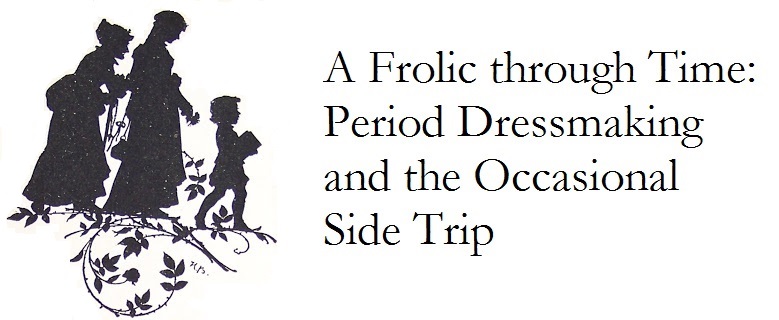
Just ended, a marathon session to make a mid-nineteenth century style chemise. I am wearing the end result as a nightgown and it's very comfortable. The chemise features tucks on the neckband, soon to be ornamented with tatting, and hand-sewn and stroked gathers and flat-felled seams. It's made of a crisp 200-c0unt cotton muslin.
I drafted the pattern using the instructions on
Elizabeth Stewart Clark's site, a process which took less than an hour all told, and was very straightforward.
Made of only five pieces (front, back, two bias sleeves and a neckband), the basic seams and the tucked neckband were sewn and felled in about two hours. I did make two mistakes:
- I did not sew each sleeve and side seam as a single seam, which means that I have awkward joins in the felled seams at that point.
- Although I added 3/4 of an inch for three quarter-inch tucks to the 2-inch wide neckband, I didn't account for fabric thickness, and although I wanted the tucks to sit right next to each other, there was still a need for perhaps another quarter inch. Then too, I set the lowest tuck too close to the neckband seam. As a result, parts of the lowest tuck were caught in that seam when I handstitched that this afternoon. The error will be hidden by tatting soon.
Hand-sewing small tight gathering stitches in two rows took about an hour and a half, and arranging the gathers and stroking them perhaps another half hour, and hand backstitching the neckband to the gathers (1/2 inch seam allowance) another hour. To help each gather remain in place, I stroked most of them a second time right before passing a backstitch over each...almost every gather is backstitched in place; that seam is NOT coming out.
Trimming the neckband seam and hemming down the band to the inside of the chemise took another two hours, due to another mistake. That neckband was so narrow due to the tucks that it wasn't wide enough to cover the gathers on the inside. I had to cut a facing strip (straight of grain because I wanted to use the selvage) and hem the top long edge to the band and overhand the bottom long edge to the chemise. Yes, I should have cut a bias facing strip, but the process had already taken a lot of time...perhaps the chemise band doesn't lay flat as it should, but for a first chemise for this period, I am happy.
Then I hand-stitched the sleeve seam and hand felled it, and hand-hemmed the sleeve edges (another two hours) and the chemise was complete.
The machine you see in the picture at the top? That's what I used for the machined seams in this project. It's a vintage Willcox and Gibbs electric chainstitch machine from the first half of the twentieth century. The machine is so pretty and in pristine, bran-span-new, mint condition and very smooth. One does have to think before seaming, since there is a right side and a wrong side to the stitching, and one MUST match stitch length to thread type and fabric weight, and one has less control of speed of stitching than on a treadle, but still, it was a true pleasure to use. Thank you, Miz Johnny, for loaning it to me while I sojourn at my mother's house this week!
I will add more pictures tomorrow, but in the meantime you can see them on my Photobucket account at
http://s83.photobucket.com/albums/j306/ZipZIpInkspot/
 Just ended, a marathon session to make a mid-nineteenth century style chemise. I am wearing the end result as a nightgown and it's very comfortable. The chemise features tucks on the neckband, soon to be ornamented with tatting, and hand-sewn and stroked gathers and flat-felled seams. It's made of a crisp 200-c0unt cotton muslin.
I drafted the pattern using the instructions on Elizabeth Stewart Clark's site, a process which took less than an hour all told, and was very straightforward.
Made of only five pieces (front, back, two bias sleeves and a neckband), the basic seams and the tucked neckband were sewn and felled in about two hours. I did make two mistakes:
Just ended, a marathon session to make a mid-nineteenth century style chemise. I am wearing the end result as a nightgown and it's very comfortable. The chemise features tucks on the neckband, soon to be ornamented with tatting, and hand-sewn and stroked gathers and flat-felled seams. It's made of a crisp 200-c0unt cotton muslin.
I drafted the pattern using the instructions on Elizabeth Stewart Clark's site, a process which took less than an hour all told, and was very straightforward.
Made of only five pieces (front, back, two bias sleeves and a neckband), the basic seams and the tucked neckband were sewn and felled in about two hours. I did make two mistakes:

No comments:
Post a Comment